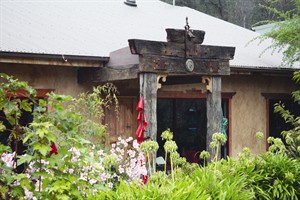Build it Back Greenbushfires
In the Media
Bruno’s Art & Sculpture Garden, and 7.5 star homes for Marysville
By Jacinta Cleary
Images: Mark Iscaro
With all but 14 of over 400 buildings destroyed in Marysville on Black Saturday, nearly three years later some homes have been rebuilt. Two of those are sustainable rebuilds by building designer First Angle, including a new home and gallery for Bruno Torfs, owner of a popular Marysville art and sculpture garden.
Mark Iscaro, a frequent visitor to Marysville, cancelled a trip to Bruno's garden on Black Saturday when he saw the extremely hot and windy forecast. A short time later his company offered to design Bruno's new home and gallery for free after learning both had been destroyed in the fires. The rebuild has happened thanks to donations from near and far, including Bruno's home country of Belgium, a fundraiser benefit in Perth and government assistance packages. Builders, tradespeople and engineers also gave their services for free, ensuring that a $800,000 home and gallery project was completed for half the price-unlikely back in 2009 with a small insurance payout. Bruno, determined to restore his gardens, gallery, home and livelihood, carried the difficult project as owner-builder for two years.
The new home is the same shape as the original much-loved fibro cottage, although a completely different lighter and brighter style, and constructed to cope with future extreme weather conditions, including possible bushfires. Although the footprint is larger the home still has a Home Energy Rating of 6.5 Stars, as does the gallery (difficult for such a large airy space) and meets the relatively high Bushfire Attack Level of BAL 29.
 To make the home and gallery more resistant to
future bushfires, and to be generally more energy efficient, the
home and gallery is built on a concrete slab, with the main
construction being concrete blocks and cement sheeting (or
blueboard) with an earth render applied by Bruno. The windows are
double glazed with aluminium frames, with commercial windows
sourced at cost from the manufacturer Southern Star Windows. At the
time, there were limited residential windows available to meet the
fire rating, although this has changed (see windows article pg
38).
To make the home and gallery more resistant to
future bushfires, and to be generally more energy efficient, the
home and gallery is built on a concrete slab, with the main
construction being concrete blocks and cement sheeting (or
blueboard) with an earth render applied by Bruno. The windows are
double glazed with aluminium frames, with commercial windows
sourced at cost from the manufacturer Southern Star Windows. At the
time, there were limited residential windows available to meet the
fire rating, although this has changed (see windows article pg
38).
The large windows are north facing to help heat winter thermal mass with a thick batch of woollen insulation to retain coolness and warmth. Natural cooling is aided via the vaulted ceilings with highlight windows providing a thermal chimney for hot air to be pushed out in summer. The louvres incorporate low-E thermal glazing.
Energy use is kept to a minimum with LED downlights in the home and a solar hot water system. With a large sculpture garden to maintain, the property is as self-sufficient as possible for water, with a large rainwater supply including 10,000 litres in the basement and a greywater treatment system.
Along with the various volunteer tradespeople, Bruno did a lot of the labour himself over his two years as an owner builder, including laying heavy concrete blocks. Holmesglen College students, featured in ReNew 111 for their work on a bushfire-resistant Venus Bay home, constructed the hand-crafted roof trusses at their school in Melbourne, delivered on a truck to Marysville.
Both the house and gallery have a very crafty look and feel through the use of salvaged materials wherever possible, including a beautiful tree inside, felled in the fires and now used as a support post for part of the roof load. A batch of old posts from the old Princess Pier, left lying near the Westgate Bridge, have been put to good use in the gallery to hold the vaulted roof. The front door is relatively fire-resistant, made from salvaged sheet metal.
With a love for art and nature the buildings and gardens are a work in progress for Bruno, with much detail and woodwork constantly added. Nearly three years after the fires the sculpture gardens and gallery officially reopened in early November, a grander yet more energy efficient and fire-ready structure than stood before.
7.5 Star Marysville home
First Angle designed another Marysville rebuild, described as "a very easy project", no doubt a relief for the owners after the trauma of losing their home. The path of the bushfire in homeowner John's street was unpredictable, destroying his house, leaving his neighbour's standing, and the next one gone. The original home was a weatherboard cottage, with the owners deciding on a modern, sustainable rebuild.
The new home is larger than the last but holds a 7.5 Star Home Energy rating thanks to a range of passive solar design features such as good thermal mass and high levels of insulation. Natural cooling features include a thermal chimney, where high-level windows flush hot air, thanks to significant air flow created by 5.5 metre vaulted ceilings. Dowell louvre windows were selected over double glazed units to allow natural air flow throughout, although double glazed windows would have pushed the home energy rating even higher. Sustainable timbers have been used throughout, including reclaimed Brush Box timber.
Non-combustible materials have been used where possible to meet a BAL 19 rating including scyon linea weatherboard made from low-density cement, and concrete blocks. The roof and floors are well sealed against embers, with the wide 700mm eaves lined and sealed with cement sheets. Windows are largely north facing, for the views and thermal benefits, and have been kept to a minimum elsewhere, particularly on the west.
The only heater is quite deliberately a wood burner to avoid having bottled gas on the property, with exploding gas cylinders a problem on Black Saturday. A fan at the top of the chimney pushes the heat to a back room, and with an already high home energy rating the home stays naturally warm.
 A 5kW
grid-connected solar power system provides all of the electricity
needs and there's a solar hot water system installed. A large
rainwater tank capacity for use in the garden and toilets provides
some independent rainwater supply, along with a greywater treatment
system.
A 5kW
grid-connected solar power system provides all of the electricity
needs and there's a solar hot water system installed. A large
rainwater tank capacity for use in the garden and toilets provides
some independent rainwater supply, along with a greywater treatment
system.
"This home encapsulates drive for change in the community with its high energy efficiency and use of solid earthly materials," says Mark.
[Article reprinted from the January-March 2012 edition of ATA's ReNew magazine.]


